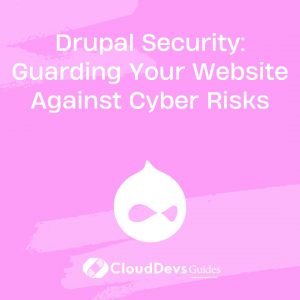Drupal Security: Guarding Your Website Against Cyber Risks
Drupal is a powerful and flexible content management system (CMS) that powers a significant portion of websites on the internet. While it offers a wide range of features and customization options, it’s essential to prioritize Drupal security to safeguard your website from potential threats and vulnerabilities. In this blog post, we will explore Drupal security best practices with practical examples to help you fortify your website’s defenses.

1. Keep Drupal Core, Modules, and Themes Updated
One of the most critical Drupal security measures is to keep your CMS, modules, and themes up to date. The Drupal security team regularly releases updates and patches to address vulnerabilities. Failing to apply these updates can leave your site exposed to known exploits.
Example:
– Use Drupal’s built-in update manager to check for available updates.
– Schedule regular maintenance to ensure your website remains current with security fixes.
2. Use Strong Authentication and Password Policies
Enforce strong authentication and password policies to prevent unauthorized access to your Drupal site. Implementing two-factor authentication (2FA) can add an extra layer of security.
Example:
– Utilize modules like “Login Security” to limit login attempts and block suspicious IPs.
– Configure password policies to require complex passwords.
3. Secure File Uploads
If your website allows file uploads, it’s crucial to secure this feature to prevent malicious file execution. Ensure that only authorized users can upload files and limit the file types that can be uploaded.
Example:
– Use the “File MIME” module to restrict allowed file types.
– Store uploaded files outside of the web root to prevent direct access.
4. Implement Content Security Policies (CSP)
Content Security Policies help protect your site against cross-site scripting (XSS) and other injection attacks by defining which content sources are allowed. A well-configured CSP can mitigate the risk of XSS vulnerabilities.
Example:
– Add a Content Security Policy header to your Drupal site’s .htaccess file or server configuration.
– Test your CSP using online tools like Mozilla’s Observatory.
5. Regularly Backup Your Website
Having up-to-date backups is crucial in case of a security breach or other disasters. Ensure that your backups are stored securely and are easily accessible for restoration.
Example:
– Use Drupal backup modules like “Backup and Migrate” to automate backup creation.
– Store backups on a separate server or cloud storage with access controls.
6. Monitor and Review User Permissions
Review and manage user permissions regularly to ensure that only authorized users have access to sensitive areas of your website. Remove unnecessary permissions and roles.
Example:
– Conduct periodic access audits to identify and rectify permission discrepancies.
– Implement the principle of least privilege to restrict user access to only what they need.
7. Employ Web Application Firewall (WAF)
A Web Application Firewall can help protect your Drupal site from various types of attacks, including SQL injection, cross-site scripting (XSS), and distributed denial of service (DDoS) attacks.
Example:
– Use a WAF service like Cloudflare or implement a WAF module in Drupal to filter and block malicious traffic.
8. Regular Security Scanning and Penetration Testing
Regularly scan your Drupal site for vulnerabilities using security scanning tools and consider conducting penetration tests to identify potential weaknesses.
Example:
– Tools like Drupal Security Scanner and OWASP ZAP can help scan for vulnerabilities.
– Hire professional penetration testers to simulate real-world attacks.
9. Keep Error Reporting Secure
Avoid displaying detailed error messages to users, as they can provide valuable information to potential attackers. Configure Drupal to log errors securely.
Example:
– Set the “Error Level” to “None” in Drupal’s error reporting settings.
– Configure error logging to save logs to a secure location and restrict access.
10. Be Cautious with Third-Party Modules and Themes
When installing third-party modules and themes, be selective and choose reputable sources. Always review their code and release history for security updates.
Example:
– Use modules and themes from the official Drupal.org repository whenever possible.
– Keep third-party modules and themes up to date to receive security patches.
Conclusion
Protecting your Drupal website from security threats should be a top priority. By following these Drupal security best practices and examples, you can significantly reduce the risk of vulnerabilities and ensure the long-term security and integrity of your website. Stay vigilant, stay updated, and stay secure to maintain a robust and safe online presence.
Table of Contents







